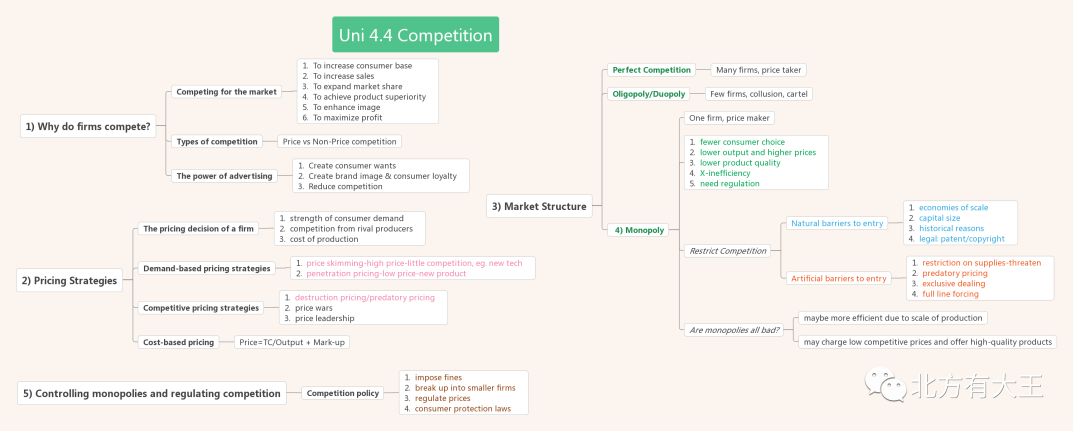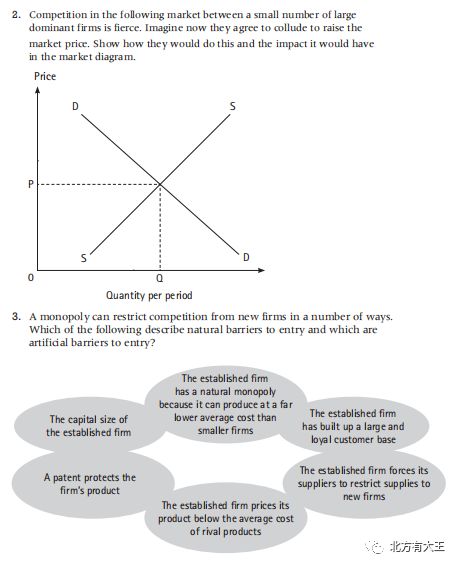- 翰林提供学术活动、国际课程、科研项目一站式留学背景提升服务!
- 400 888 0080
IGCSE经济-竞争
IGCSEECONOMICS 经济学— 4.4 —ChapterHello同学们!最难的一章来了
Competition《竞争》
来看看本章关于Competition的知识点脑图
 本章的作业选择题
本章的作业选择题
1. Which of the following is a feature of a perfectly competitive market?
A. A differentiated product
B. Few buyers and sellers
C. Imperfect information
D. No barriers to entry and exit
2. In which of the following market structures do firms recognize their mutual interdependence?
A Oligopoly
B Monopoly
C Perfect competition
D Monopsony
3. Most economists argue that a monopoly is inefficient because it
A has no incentive to minimize its costs
B produces too little output and sets a price above marginal cost
C earns too much profit by charging consumers any price it wants
D produces too much output and thus wastes scarce resources
4. One difference between a firm in a perfectly competitive market and an unregulated monopoly is that the
A perfectly competitive firm can increase the quantity it sells at the market price, whereas the monopoly must lower its price to sell more
B perfectly competitive firm sells differentiated products, whereas the monopoly sells a homogeneous product
C price elasticity of demand for a monopoly is much higher than that for a perfectly competitive firm
D monopolist seeks to maximize profits, whereas the perfectly competitive firm maximizes revenues
5. A monopolist is inefficient from society’s point of view because
A it overproduces output and charges a price above marginal cost
B it underproduces output and charges a price above marginal cost
C it sometimes colludes with other firms to obtain higher prices
D the price the monopolist charges is too low and it does not advertise
6. The primary purpose of antitrust laws is to
A protect consumers from fraudulent business practices
B protect small businesses from unfair foreign competition
C prevent firms from monopolizing trade and to promote competition
D reduce lawsuits and limit the liabilities of businesses
7. Which of the following is a source of monopoly power?
A Scarcity
B Elasticity of demand
C Barriers to entry
D Low profits
8. Which of the following enables a seller to capture the entire consumer surplus in a market?
A Perfect price discrimination
B Perfect competition
C An excise tax on buyers
D Effective price ceiling
9. Which one of following pricing strategies is most likely to be used by a dominant firm trying to undercut new competition?
A Penetration pricing
B Costing-plus pricing
C Price skimming
D Destruction pricing
10. Prices tend to be lower in a competitive industry than in a monopoly. Why is this?
A. A monopoly has less influence on the market
B. Competitve industry has more economies of scales
C. New firms are free to enter the market
D. Profits are lower in monopoly
11. A market dominated by one or a handful of firms may be highly contestable if:
A. Artificial barriers to entry are significant
B. There are no natural barrier to entry
C. Barrier to entry are low
D. Existing firms have legal monopolies
12. If a pure monopoly restricts market supply of a product, the most likely outcome will be:
A. A fall in demand
B. A price war with rival producer
C. A fall in profit
D. A rise in market price
13. A market dominated by just two suppliers is known as:
A. A pure monopoly
B. A contestable market
C. A competitive market
D. A duopoly
14. Which of the following is an artificial barrier to entry that may be used by a monopoly to restrict competition?
A. Economies of scale in production
B. A predatory pricing strategy
C. Development of new products
D. Its significant capital size
15. India is experiencing rapid growth in air travel. The number and size of airlines is increasing every year. Which effect arising from this growth is an external economy of scale?
A. Banking are more prepared to lend to large airlines than to small airlines
B. Fuel suppliers charge lower prices to airlines that buy in bulk
C. Institutions are established to train flight crew
D. Large airlines operate aircraft which can carry more passengers
大题


最新发布
© 2026. All Rights Reserved. 沪ICP备2023009024号-1









